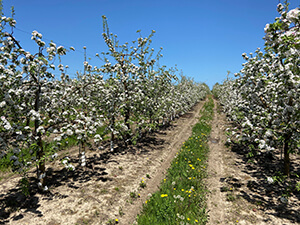
As I write this, it’s peak apple bloom here in New York. All the big orchards in our Big Apple state are filled with pallets of hives and the bees are busily doing their thing. Since apples are worth ~$320 million/year in New York, and apple is also ~90% reliant on insect pollination to produce fruit, those bees are currently delivering ~$288 million in pollination services.
At the same time, apple growers are protecting their crop from potentially devastating insect pests such as the European apple sawfly and rosy apple aphid, or diseases such as apple scab and fire blight. Most growers apply a variety of insecticides, fungicides and bactericides to their trees in the fall and prior to bloom to control pests and diseases. Since many of those pesticides are systemic (i.e., they’re taken up into plant tissues), they can potentially accumulate in pollen and nectar during bloom and expose bees to harmful chemicals.
So, are fall and pre-bloom pesticide sprays safe for bees? Given the economic importance of apple pollination, any beekeeper, grower or consumer of apples or apple products should want to know. This is the topic for our thirty-first “Notes from the Lab,” where we highlight “Pollinator exposure to systemic insecticides and fungicides applied in the previous fall and pre-bloom period in apple orchards,” written by Sarah Heller and colleagues and published in Environmental Pollution [114589 (2020)].
For their study, Heller and colleagues actually conducted two different studies. First, the authors applied one of six systemic insecticide or fungicide products to groups of 20-year-old apple trees: Assail 30SG (active ingredient acetamiprid), Calypso 480SC (thiacloprid), Actara 25WP (thiamethoxam), Provado 1.6EC (imidacloprid), Closer 240SC (sulfoxaflor), or Nova 40W (myclobutanil). The pesticides were applied once (5-7 days before bloom) at commercially-recommended rates via a standard airblast sprayer. Provado 1.6EC (imidacloprid) is not labeled for pre-bloom application but was included as a positive control since it’s a commonly-used systemic insecticide outside of the pre-bloom and bloom periods.
Second, the authors conducted a fall pesticide treatment on different trees. For this experiment, Heller and colleagues applied one of five systemic insecticide products: Endigo ZC (active ingredients thiamethoxam and lambda-cyhalothrin), Leverage (imidacloprid and beta-cyfluthrin), Scorpion 35SL (dinotefuran), Belay 2.13SC (clothianidin), and Closer 240SC (sulfoxaflor). Each pesticide product was applied 1-4 times via an airblast sprayer in August and/or September according to management guidelines for the brown marmorated stink bug.
For both studies, whole flowers, pollen and nectar were collected at peak bloom for each group of plants and analyzed for concentrations of each systemic insecticide or fungicide. Pesticide analyses occurred via liquid chromatography-mass spectrometry (LC-MS) and limits of quantification were 50 ppb for all pesticides in flower samples and 5-22 ppb for pesticides in nectar and pollen. Any detections below the limit of quantification were set to 0. In other words, the results summarized below (and shown in Figure 1) are conservative estimates of the true residue results since several low-level detections may have been set to 0 due to limitations of the LC-MS.
So, what did they find? Did pre-bloom sprays show up in the flowers, nectar or pollen during bloom? Yes. Every pesticide that was applied pre-bloom was found in the flowers, nectar and pollen during bloom with the exception of sulfoxaflor, which was not found in nectar (see Figure 1).
What about the levels of pesticides? Were they at concentrations that could harm bees? To address this question, it’s best to evaluate the contaminated pollen and nectar, since those are the resources consumed by bees. While the pesticides in nectar and pollen were not at concentrations that would acutely kill bees (i.e., death within 24-48 hours), some of the pesticides were at levels that could cause sublethal harm to bees.
For example, the average concentration of sulfoxaflor was ~80 ppb in pollen (Figure 1). That’s 20x higher than the 5 ppb sulfoxaflor that Siviter et al. (2018) dosed bumble bee colonies with for 14 days and found that ….


